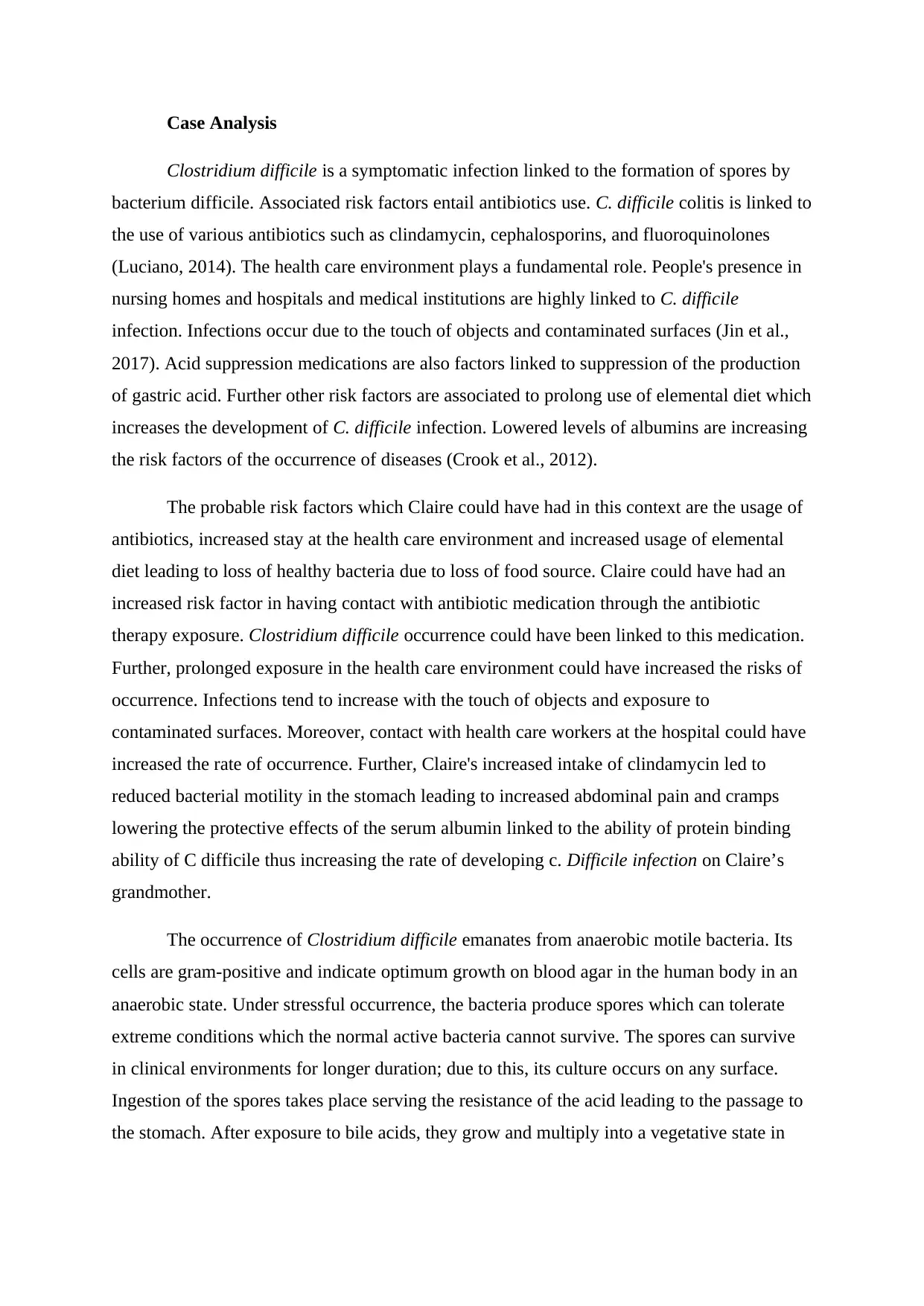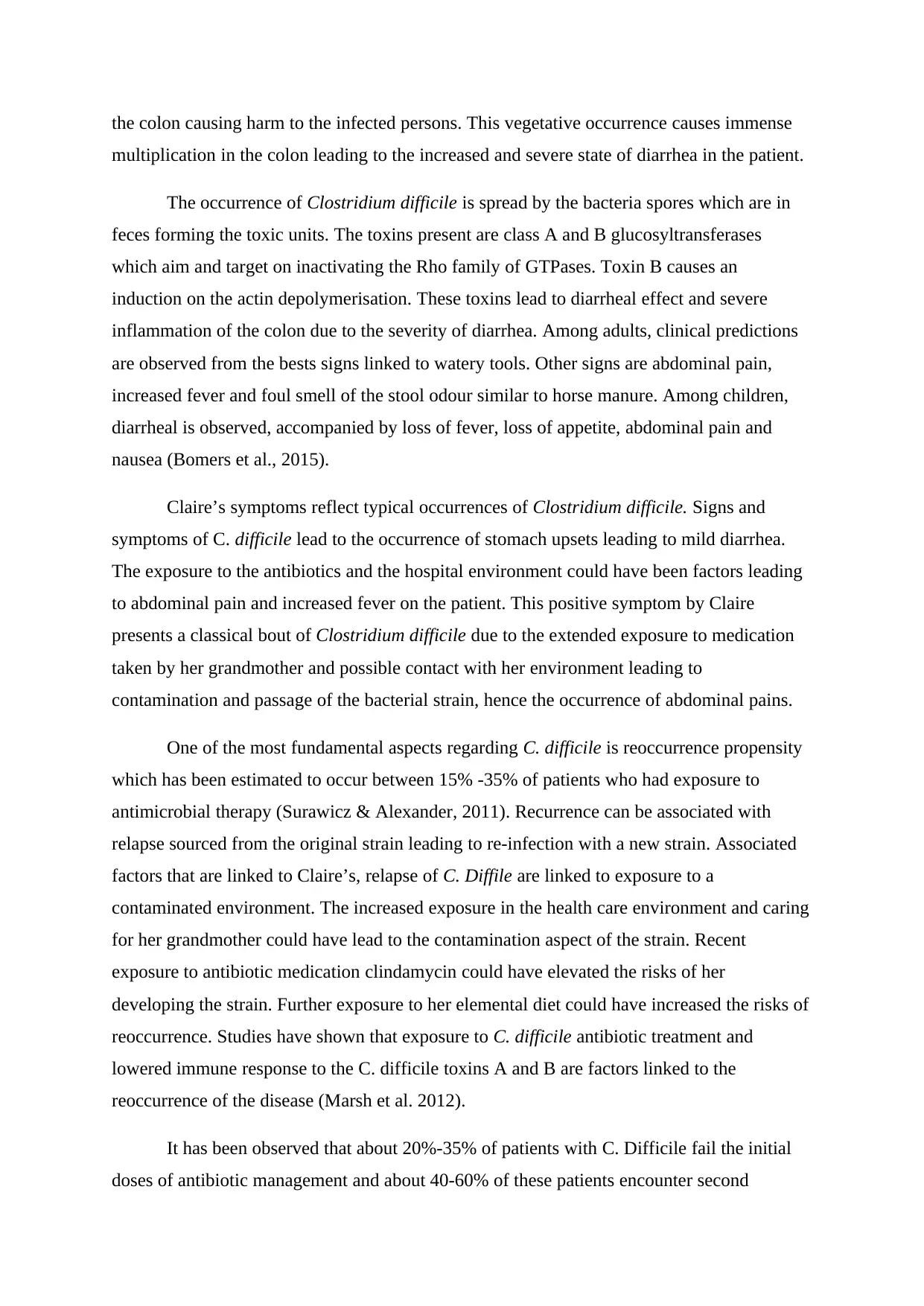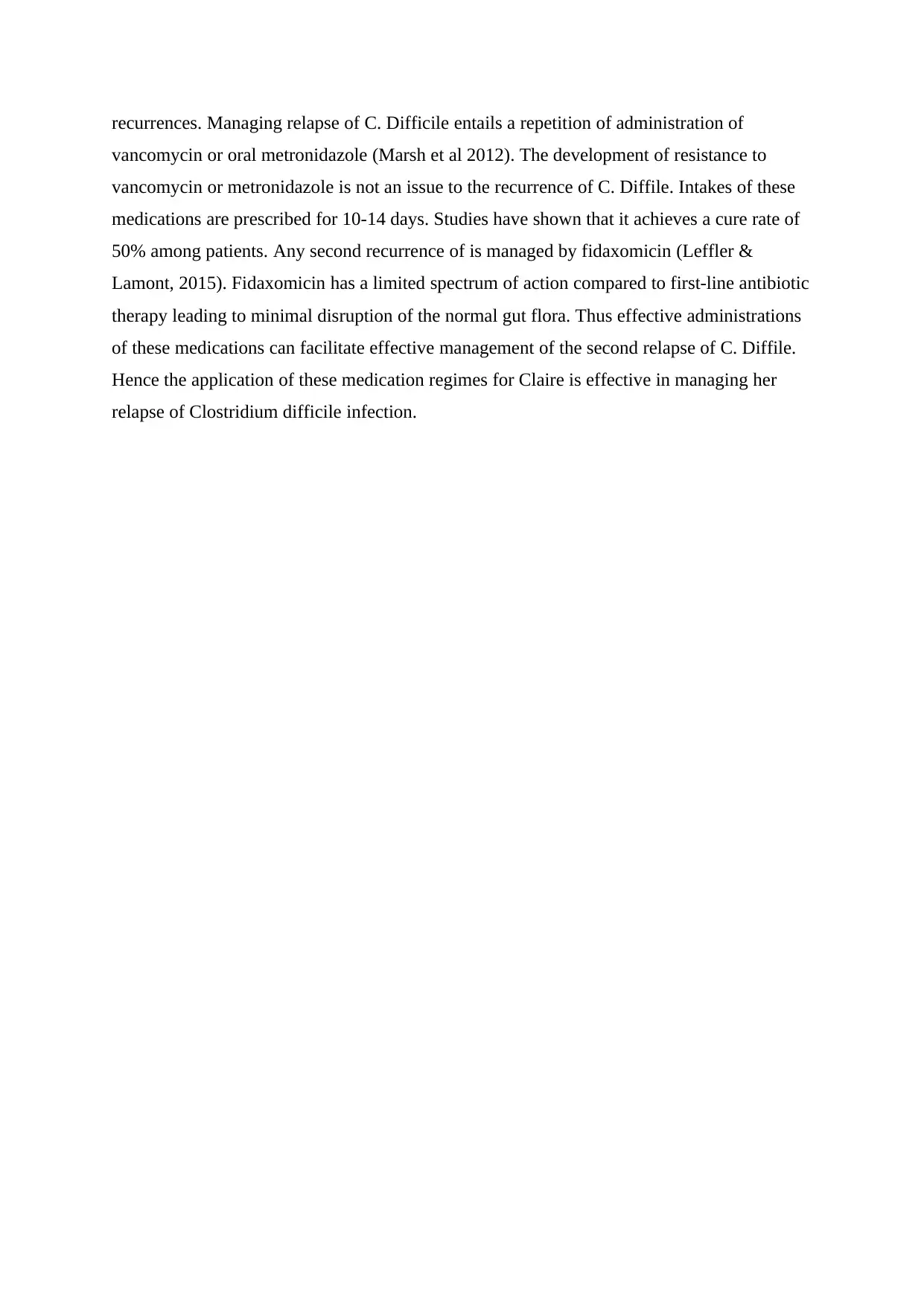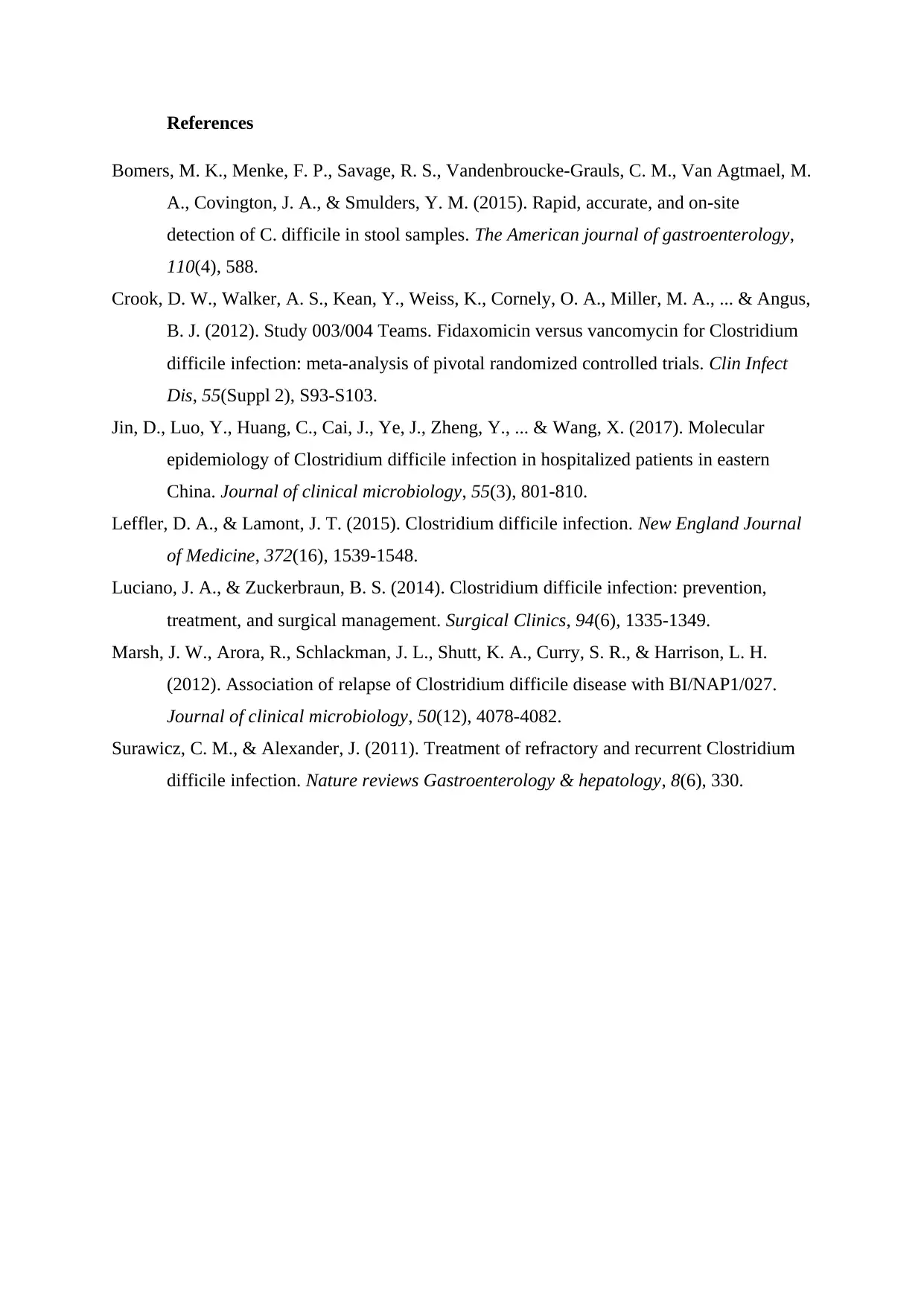Case Study Analysis: Clostridium difficile Infection in Healthcare
VerifiedAdded on 2022/09/11
|5
|1429
|9
Case Study
AI Summary
This case study analyzes a Clostridium difficile (C. difficile) infection scenario, focusing on Claire's experience and her grandmother's condition. The analysis identifies key risk factors, including antibiotic use, healthcare environment exposure, and elemental diet, contributing to the development and potential relapse of C. difficile. The case study outlines the pathophysiology of C. difficile, explaining how the bacteria's spores and toxins lead to colitis and related symptoms. It highlights the clinical presentation, diagnostic considerations, and the propensity for recurrence. The study further discusses treatment strategies, including the use of antibiotics like vancomycin and fidaxomicin, and emphasizes the importance of managing relapses. The provided references support the analysis, providing a comprehensive understanding of the infection and its management.

Case Study Analysis
University
Task
Name
Unit
Date
University
Task
Name
Unit
Date
Paraphrase This Document
Need a fresh take? Get an instant paraphrase of this document with our AI Paraphraser

Case Analysis
Clostridium difficile is a symptomatic infection linked to the formation of spores by
bacterium difficile. Associated risk factors entail antibiotics use. C. difficile colitis is linked to
the use of various antibiotics such as clindamycin, cephalosporins, and fluoroquinolones
(Luciano, 2014). The health care environment plays a fundamental role. People's presence in
nursing homes and hospitals and medical institutions are highly linked to C. difficile
infection. Infections occur due to the touch of objects and contaminated surfaces (Jin et al.,
2017). Acid suppression medications are also factors linked to suppression of the production
of gastric acid. Further other risk factors are associated to prolong use of elemental diet which
increases the development of C. difficile infection. Lowered levels of albumins are increasing
the risk factors of the occurrence of diseases (Crook et al., 2012).
The probable risk factors which Claire could have had in this context are the usage of
antibiotics, increased stay at the health care environment and increased usage of elemental
diet leading to loss of healthy bacteria due to loss of food source. Claire could have had an
increased risk factor in having contact with antibiotic medication through the antibiotic
therapy exposure. Clostridium difficile occurrence could have been linked to this medication.
Further, prolonged exposure in the health care environment could have increased the risks of
occurrence. Infections tend to increase with the touch of objects and exposure to
contaminated surfaces. Moreover, contact with health care workers at the hospital could have
increased the rate of occurrence. Further, Claire's increased intake of clindamycin led to
reduced bacterial motility in the stomach leading to increased abdominal pain and cramps
lowering the protective effects of the serum albumin linked to the ability of protein binding
ability of C difficile thus increasing the rate of developing c. Difficile infection on Claire’s
grandmother.
The occurrence of Clostridium difficile emanates from anaerobic motile bacteria. Its
cells are gram-positive and indicate optimum growth on blood agar in the human body in an
anaerobic state. Under stressful occurrence, the bacteria produce spores which can tolerate
extreme conditions which the normal active bacteria cannot survive. The spores can survive
in clinical environments for longer duration; due to this, its culture occurs on any surface.
Ingestion of the spores takes place serving the resistance of the acid leading to the passage to
the stomach. After exposure to bile acids, they grow and multiply into a vegetative state in
Clostridium difficile is a symptomatic infection linked to the formation of spores by
bacterium difficile. Associated risk factors entail antibiotics use. C. difficile colitis is linked to
the use of various antibiotics such as clindamycin, cephalosporins, and fluoroquinolones
(Luciano, 2014). The health care environment plays a fundamental role. People's presence in
nursing homes and hospitals and medical institutions are highly linked to C. difficile
infection. Infections occur due to the touch of objects and contaminated surfaces (Jin et al.,
2017). Acid suppression medications are also factors linked to suppression of the production
of gastric acid. Further other risk factors are associated to prolong use of elemental diet which
increases the development of C. difficile infection. Lowered levels of albumins are increasing
the risk factors of the occurrence of diseases (Crook et al., 2012).
The probable risk factors which Claire could have had in this context are the usage of
antibiotics, increased stay at the health care environment and increased usage of elemental
diet leading to loss of healthy bacteria due to loss of food source. Claire could have had an
increased risk factor in having contact with antibiotic medication through the antibiotic
therapy exposure. Clostridium difficile occurrence could have been linked to this medication.
Further, prolonged exposure in the health care environment could have increased the risks of
occurrence. Infections tend to increase with the touch of objects and exposure to
contaminated surfaces. Moreover, contact with health care workers at the hospital could have
increased the rate of occurrence. Further, Claire's increased intake of clindamycin led to
reduced bacterial motility in the stomach leading to increased abdominal pain and cramps
lowering the protective effects of the serum albumin linked to the ability of protein binding
ability of C difficile thus increasing the rate of developing c. Difficile infection on Claire’s
grandmother.
The occurrence of Clostridium difficile emanates from anaerobic motile bacteria. Its
cells are gram-positive and indicate optimum growth on blood agar in the human body in an
anaerobic state. Under stressful occurrence, the bacteria produce spores which can tolerate
extreme conditions which the normal active bacteria cannot survive. The spores can survive
in clinical environments for longer duration; due to this, its culture occurs on any surface.
Ingestion of the spores takes place serving the resistance of the acid leading to the passage to
the stomach. After exposure to bile acids, they grow and multiply into a vegetative state in

the colon causing harm to the infected persons. This vegetative occurrence causes immense
multiplication in the colon leading to the increased and severe state of diarrhea in the patient.
The occurrence of Clostridium difficile is spread by the bacteria spores which are in
feces forming the toxic units. The toxins present are class A and B glucosyltransferases
which aim and target on inactivating the Rho family of GTPases. Toxin B causes an
induction on the actin depolymerisation. These toxins lead to diarrheal effect and severe
inflammation of the colon due to the severity of diarrhea. Among adults, clinical predictions
are observed from the bests signs linked to watery tools. Other signs are abdominal pain,
increased fever and foul smell of the stool odour similar to horse manure. Among children,
diarrheal is observed, accompanied by loss of fever, loss of appetite, abdominal pain and
nausea (Bomers et al., 2015).
Claire’s symptoms reflect typical occurrences of Clostridium difficile. Signs and
symptoms of C. difficile lead to the occurrence of stomach upsets leading to mild diarrhea.
The exposure to the antibiotics and the hospital environment could have been factors leading
to abdominal pain and increased fever on the patient. This positive symptom by Claire
presents a classical bout of Clostridium difficile due to the extended exposure to medication
taken by her grandmother and possible contact with her environment leading to
contamination and passage of the bacterial strain, hence the occurrence of abdominal pains.
One of the most fundamental aspects regarding C. difficile is reoccurrence propensity
which has been estimated to occur between 15% -35% of patients who had exposure to
antimicrobial therapy (Surawicz & Alexander, 2011). Recurrence can be associated with
relapse sourced from the original strain leading to re-infection with a new strain. Associated
factors that are linked to Claire’s, relapse of C. Diffile are linked to exposure to a
contaminated environment. The increased exposure in the health care environment and caring
for her grandmother could have lead to the contamination aspect of the strain. Recent
exposure to antibiotic medication clindamycin could have elevated the risks of her
developing the strain. Further exposure to her elemental diet could have increased the risks of
reoccurrence. Studies have shown that exposure to C. difficile antibiotic treatment and
lowered immune response to the C. difficile toxins A and B are factors linked to the
reoccurrence of the disease (Marsh et al. 2012).
It has been observed that about 20%-35% of patients with C. Difficile fail the initial
doses of antibiotic management and about 40-60% of these patients encounter second
multiplication in the colon leading to the increased and severe state of diarrhea in the patient.
The occurrence of Clostridium difficile is spread by the bacteria spores which are in
feces forming the toxic units. The toxins present are class A and B glucosyltransferases
which aim and target on inactivating the Rho family of GTPases. Toxin B causes an
induction on the actin depolymerisation. These toxins lead to diarrheal effect and severe
inflammation of the colon due to the severity of diarrhea. Among adults, clinical predictions
are observed from the bests signs linked to watery tools. Other signs are abdominal pain,
increased fever and foul smell of the stool odour similar to horse manure. Among children,
diarrheal is observed, accompanied by loss of fever, loss of appetite, abdominal pain and
nausea (Bomers et al., 2015).
Claire’s symptoms reflect typical occurrences of Clostridium difficile. Signs and
symptoms of C. difficile lead to the occurrence of stomach upsets leading to mild diarrhea.
The exposure to the antibiotics and the hospital environment could have been factors leading
to abdominal pain and increased fever on the patient. This positive symptom by Claire
presents a classical bout of Clostridium difficile due to the extended exposure to medication
taken by her grandmother and possible contact with her environment leading to
contamination and passage of the bacterial strain, hence the occurrence of abdominal pains.
One of the most fundamental aspects regarding C. difficile is reoccurrence propensity
which has been estimated to occur between 15% -35% of patients who had exposure to
antimicrobial therapy (Surawicz & Alexander, 2011). Recurrence can be associated with
relapse sourced from the original strain leading to re-infection with a new strain. Associated
factors that are linked to Claire’s, relapse of C. Diffile are linked to exposure to a
contaminated environment. The increased exposure in the health care environment and caring
for her grandmother could have lead to the contamination aspect of the strain. Recent
exposure to antibiotic medication clindamycin could have elevated the risks of her
developing the strain. Further exposure to her elemental diet could have increased the risks of
reoccurrence. Studies have shown that exposure to C. difficile antibiotic treatment and
lowered immune response to the C. difficile toxins A and B are factors linked to the
reoccurrence of the disease (Marsh et al. 2012).
It has been observed that about 20%-35% of patients with C. Difficile fail the initial
doses of antibiotic management and about 40-60% of these patients encounter second
⊘ This is a preview!⊘
Do you want full access?
Subscribe today to unlock all pages.

Trusted by 1+ million students worldwide

recurrences. Managing relapse of C. Difficile entails a repetition of administration of
vancomycin or oral metronidazole (Marsh et al 2012). The development of resistance to
vancomycin or metronidazole is not an issue to the recurrence of C. Diffile. Intakes of these
medications are prescribed for 10-14 days. Studies have shown that it achieves a cure rate of
50% among patients. Any second recurrence of is managed by fidaxomicin (Leffler &
Lamont, 2015). Fidaxomicin has a limited spectrum of action compared to first-line antibiotic
therapy leading to minimal disruption of the normal gut flora. Thus effective administrations
of these medications can facilitate effective management of the second relapse of C. Diffile.
Hence the application of these medication regimes for Claire is effective in managing her
relapse of Clostridium difficile infection.
vancomycin or oral metronidazole (Marsh et al 2012). The development of resistance to
vancomycin or metronidazole is not an issue to the recurrence of C. Diffile. Intakes of these
medications are prescribed for 10-14 days. Studies have shown that it achieves a cure rate of
50% among patients. Any second recurrence of is managed by fidaxomicin (Leffler &
Lamont, 2015). Fidaxomicin has a limited spectrum of action compared to first-line antibiotic
therapy leading to minimal disruption of the normal gut flora. Thus effective administrations
of these medications can facilitate effective management of the second relapse of C. Diffile.
Hence the application of these medication regimes for Claire is effective in managing her
relapse of Clostridium difficile infection.
Paraphrase This Document
Need a fresh take? Get an instant paraphrase of this document with our AI Paraphraser

References
Bomers, M. K., Menke, F. P., Savage, R. S., Vandenbroucke-Grauls, C. M., Van Agtmael, M.
A., Covington, J. A., & Smulders, Y. M. (2015). Rapid, accurate, and on-site
detection of C. difficile in stool samples. The American journal of gastroenterology,
110(4), 588.
Crook, D. W., Walker, A. S., Kean, Y., Weiss, K., Cornely, O. A., Miller, M. A., ... & Angus,
B. J. (2012). Study 003/004 Teams. Fidaxomicin versus vancomycin for Clostridium
difficile infection: meta-analysis of pivotal randomized controlled trials. Clin Infect
Dis, 55(Suppl 2), S93-S103.
Jin, D., Luo, Y., Huang, C., Cai, J., Ye, J., Zheng, Y., ... & Wang, X. (2017). Molecular
epidemiology of Clostridium difficile infection in hospitalized patients in eastern
China. Journal of clinical microbiology, 55(3), 801-810.
Leffler, D. A., & Lamont, J. T. (2015). Clostridium difficile infection. New England Journal
of Medicine, 372(16), 1539-1548.
Luciano, J. A., & Zuckerbraun, B. S. (2014). Clostridium difficile infection: prevention,
treatment, and surgical management. Surgical Clinics, 94(6), 1335-1349.
Marsh, J. W., Arora, R., Schlackman, J. L., Shutt, K. A., Curry, S. R., & Harrison, L. H.
(2012). Association of relapse of Clostridium difficile disease with BI/NAP1/027.
Journal of clinical microbiology, 50(12), 4078-4082.
Surawicz, C. M., & Alexander, J. (2011). Treatment of refractory and recurrent Clostridium
difficile infection. Nature reviews Gastroenterology & hepatology, 8(6), 330.
Bomers, M. K., Menke, F. P., Savage, R. S., Vandenbroucke-Grauls, C. M., Van Agtmael, M.
A., Covington, J. A., & Smulders, Y. M. (2015). Rapid, accurate, and on-site
detection of C. difficile in stool samples. The American journal of gastroenterology,
110(4), 588.
Crook, D. W., Walker, A. S., Kean, Y., Weiss, K., Cornely, O. A., Miller, M. A., ... & Angus,
B. J. (2012). Study 003/004 Teams. Fidaxomicin versus vancomycin for Clostridium
difficile infection: meta-analysis of pivotal randomized controlled trials. Clin Infect
Dis, 55(Suppl 2), S93-S103.
Jin, D., Luo, Y., Huang, C., Cai, J., Ye, J., Zheng, Y., ... & Wang, X. (2017). Molecular
epidemiology of Clostridium difficile infection in hospitalized patients in eastern
China. Journal of clinical microbiology, 55(3), 801-810.
Leffler, D. A., & Lamont, J. T. (2015). Clostridium difficile infection. New England Journal
of Medicine, 372(16), 1539-1548.
Luciano, J. A., & Zuckerbraun, B. S. (2014). Clostridium difficile infection: prevention,
treatment, and surgical management. Surgical Clinics, 94(6), 1335-1349.
Marsh, J. W., Arora, R., Schlackman, J. L., Shutt, K. A., Curry, S. R., & Harrison, L. H.
(2012). Association of relapse of Clostridium difficile disease with BI/NAP1/027.
Journal of clinical microbiology, 50(12), 4078-4082.
Surawicz, C. M., & Alexander, J. (2011). Treatment of refractory and recurrent Clostridium
difficile infection. Nature reviews Gastroenterology & hepatology, 8(6), 330.
1 out of 5
Your All-in-One AI-Powered Toolkit for Academic Success.
+13062052269
info@desklib.com
Available 24*7 on WhatsApp / Email
![[object Object]](/_next/static/media/star-bottom.7253800d.svg)
Unlock your academic potential
Copyright © 2020–2025 A2Z Services. All Rights Reserved. Developed and managed by ZUCOL.

